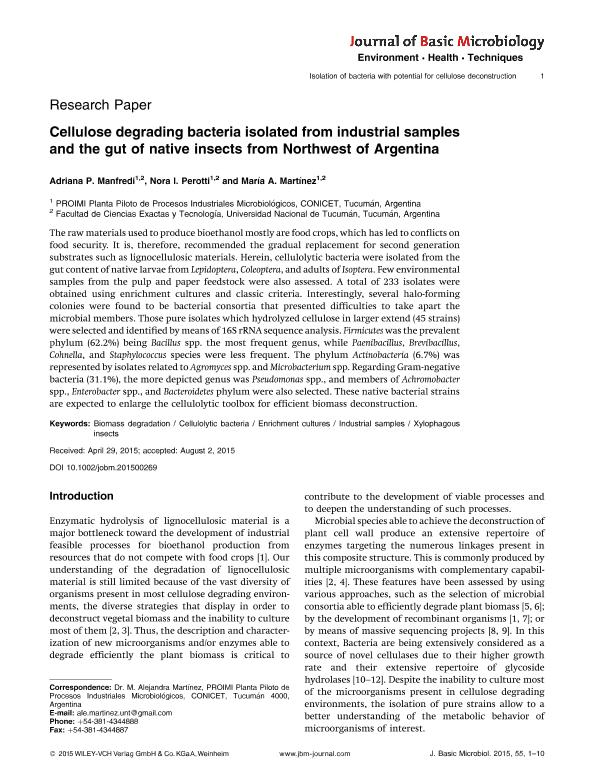Mostrar el registro sencillo del ítem
dc.contributor.author
Manfredi, Adriana Paola

dc.contributor.author
Perotti, Nora Ines

dc.contributor.author
Martinez, Maria Alejandra

dc.date.available
2017-05-23T19:17:51Z
dc.date.issued
2015-09
dc.identifier.citation
Manfredi, Adriana Paola; Perotti, Nora Ines; Martinez, Maria Alejandra; Cellulose degrading bacteria isolated from industrial samples and the gut of native insects from Northwest of Argentina; Wiley Vch Verlag; Journal Of Basic Microbiology; 55; 12; 9-2015; 1384–1393
dc.identifier.issn
0233-111X
dc.identifier.uri
http://hdl.handle.net/11336/16883
dc.description.abstract
The raw materials used to produce bioethanol mostly are food crops, which has led to conflicts on food security. It is, therefore, recommended the gradual replacement for second generation substrates such as lignocellulosic materials. Herein, cellulolytic bacteria were isolated from the gut content of native larvae from Lepidoptera, Coleoptera, and adults of Isoptera. Few environmentalsamples from the pulp and paper feedstock were also assessed. A total of 233 isolates were obtained using enrichment cultures and classic criteria. Interestingly, several halo-forming colonies were found to be bacterial consortia that presented difficulties to take apart the microbial members. Those pure isolates which hydrolyzed cellulose in larger extend (45 strains) were selected and identified by means of 16S rRNA sequence analysis. Firmicutes was the prevalent phylum (62.2%) being Bacillus spp. the most frequent genus, while Paenibacillus, Brevibacillus, Cohnella, and Staphylococcus species were less frequent. The phylum Actinobacteria (6.7%) was represented by isolates related to Agromyces spp. and Microbacterium spp. Regarding Gram-negative bacteria (31.1%), the more depicted genus was Pseudomonas spp., and members of Achromobacter spp., Enterobacter spp., and Bacteroidetes phylum were also selected. These native bacterial strains are expected to enlarge the cellulolytic toolbox for efficient biomass deconstruction.
dc.format
application/pdf
dc.language.iso
eng
dc.publisher
Wiley Vch Verlag

dc.rights
info:eu-repo/semantics/openAccess
dc.rights.uri
https://creativecommons.org/licenses/by-nc-nd/2.5/ar/
dc.subject
Biomass Degradation
dc.subject
Cellulolytic Bacteria
dc.subject
Enrichment Cultures
dc.subject
Xylophagous Insects
dc.subject
Industrial Samples
dc.subject.classification
Biología Celular, Microbiología

dc.subject.classification
Ciencias Biológicas

dc.subject.classification
CIENCIAS NATURALES Y EXACTAS

dc.title
Cellulose degrading bacteria isolated from industrial samples and the gut of native insects from Northwest of Argentina
dc.type
info:eu-repo/semantics/article
dc.type
info:ar-repo/semantics/artículo
dc.type
info:eu-repo/semantics/publishedVersion
dc.date.updated
2016-02-05T15:00:15Z
dc.journal.volume
55
dc.journal.number
12
dc.journal.pagination
1384–1393
dc.journal.pais
Alemania

dc.journal.ciudad
Weinheim
dc.description.fil
Fil: Manfredi, Adriana Paola. Consejo Nacional de Investigaciones Científicas y Técnicas. Centro Científico Tecnológico Tucumán. Planta Piloto de Procesos Industriales Microbiológicos (i); Argentina. Universidad Nacional de Tucumán; Argentina
dc.description.fil
Fil: Perotti, Nora Ines. Consejo Nacional de Investigaciones Científicas y Técnicas. Centro Científico Tecnológico Tucumán. Planta Piloto de Procesos Industriales Microbiológicos (i); Argentina. Universidad Nacional de Tucumán; Argentina
dc.description.fil
Fil: Martinez, Maria Alejandra. Consejo Nacional de Investigaciones Científicas y Técnicas. Centro Científico Tecnológico Tucumán. Planta Piloto de Procesos Industriales Microbiológicos (i); Argentina. Universidad Nacional de Tucumán; Argentina
dc.journal.title
Journal Of Basic Microbiology

dc.relation.alternativeid
info:eu-repo/semantics/altIdentifier/url/http://onlinelibrary.wiley.com/doi/10.1002/jobm.201500269/abstract
dc.relation.alternativeid
info:eu-repo/semantics/altIdentifier/doi/http://dx.doi.org/10.1002/jobm.201500269
Archivos asociados
